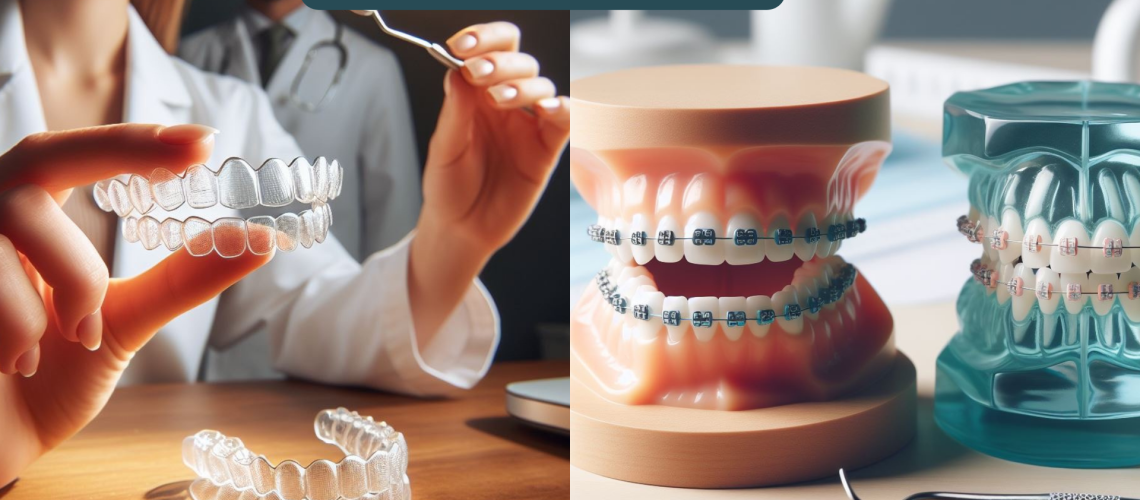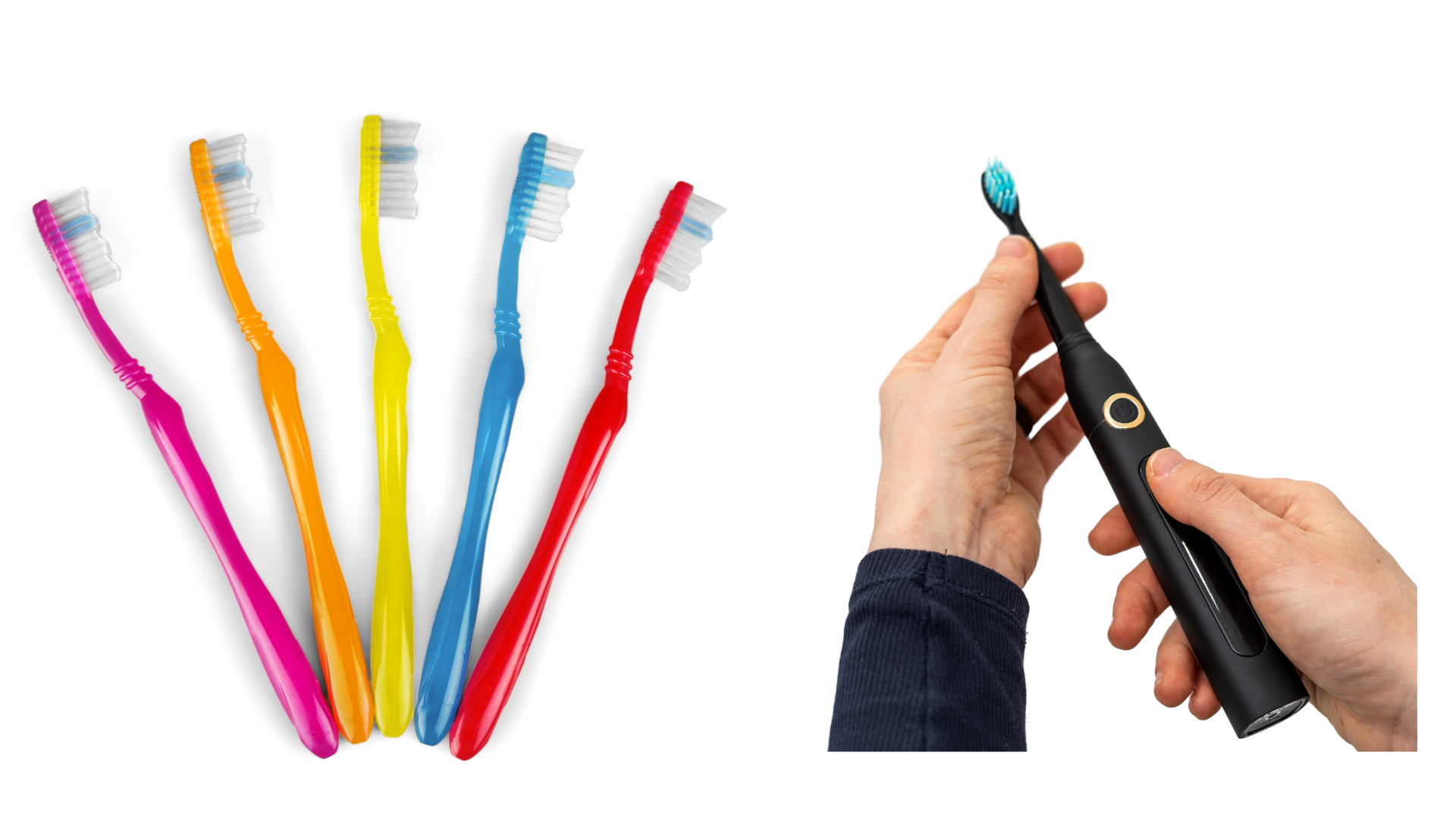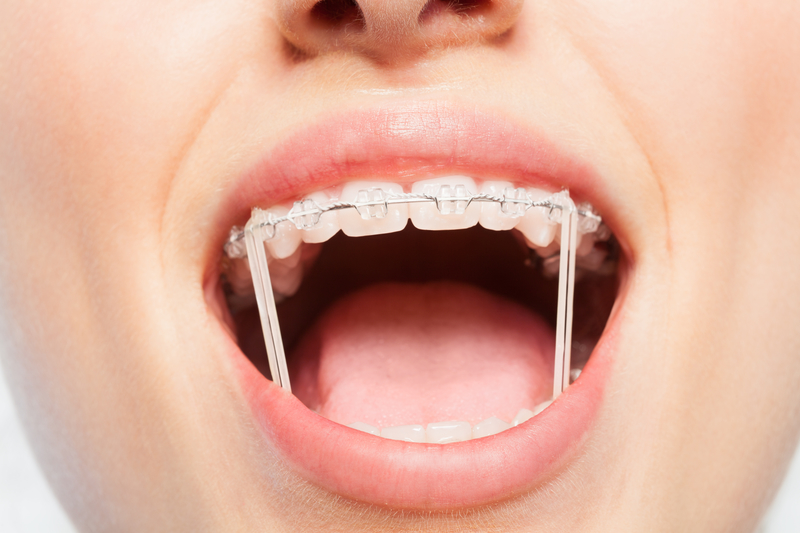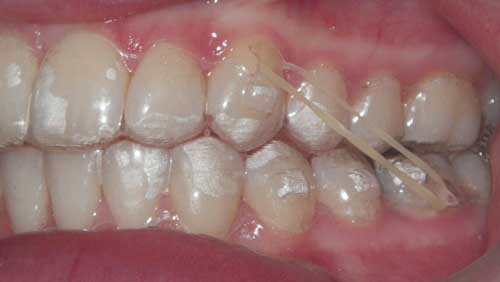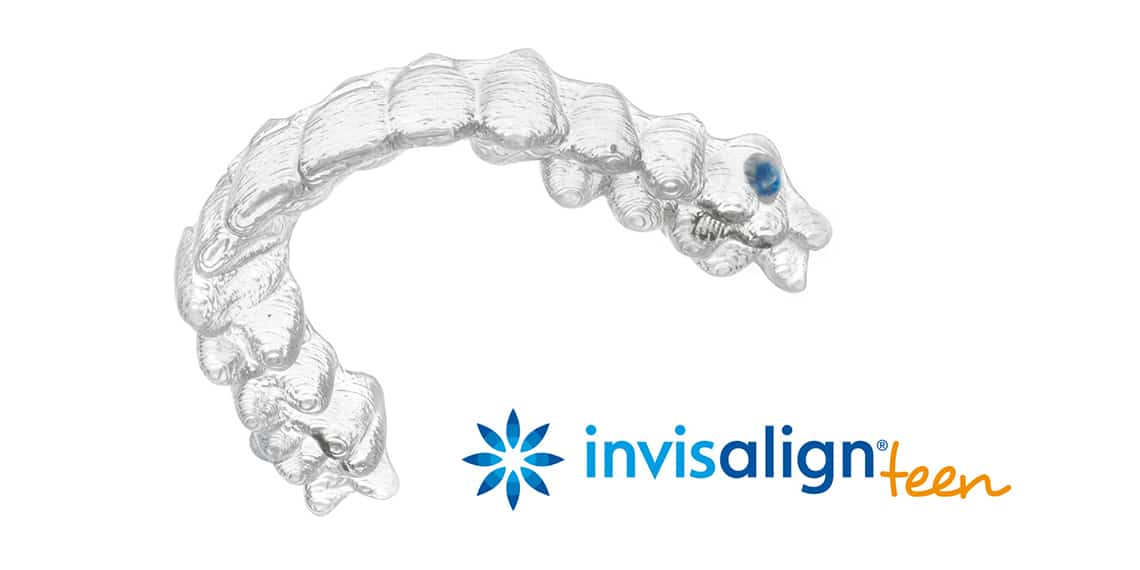Your dentist tells you that your teenager needs to see an orthodontist.
Inevitably, you are faced with a decision.
Braces vs Invisalign.
Most orthodontists will offer you both modalities for tooth movements.
Braces and Invisalign are simply 2 tools that can be used to move teeth and jaws into the
correct position.
We tell our patients that it is far more important that the teenager can do what is needed for their appliance of choice – not the appliance itself.
Biggest Differences Between Braces and Invisalign
Braces (metal braces, traditional braces, self ligating braces, clear braces)
Glued on to the teeth
Extra time and tools required for brushing and flossing
Foods that must be avoided (popcorn, chewy, sticky, crunchy)
More appointments at the orthodontist’s office
Emergency appointments (broken braces, pokey wires)
Visible on the teeth
Lips and cheeks will be sore the first few weeks
Invisalign (clear aligners, Angel, Spark, Clarity)
Removable – they can be taken in and out for eating and brushing and must be worn 22 hours a day
Brushing and flossing is the same as without Invisalign
No foods that need to be avoided
Fewer in-office visits because remote monitoring allows weekly monitoring without missing school and work for appointments
No emergency visits
Virtually invisible on the teeth
Minimal discomfort – most children and teens report 2-5 days of initial adjustment
Do Braces and Invisalign Aligners Do The Same Things?
For the most part, yes. The average treatment time in both treatment options works out to be the same. We use LightForce braces as well as clear aligners (Invisalign, Angel) and find that most bite corrections and teeth straightening happens in the same amount of time.
The results of treatment with custom made aligners (Invisalign, Angel) or braces (traditional braces, lingual braces, ceramic braces, LightForce braces) are also the same. These different appliances are simply different tools to get to the same end result.
Whether someone is in Invisalign treatment or metal braces for treatment, the goals are always the same. Having a treatment option (braces or Invisalign) is just that – an option for how to get to the end goal. Both Invisalign and metal brackets (braces) move teeth and bites into the correct position.
Braces vs Invisalign – Dental Insurance
Another common question in our office is if dental insurance treats Invisalign aligners and traditional braces the same way. Parents are often concerned that their dental insurance plan will not cover clear aligners (Invisalign, Angel). The cost of Invisalign and braces is an investment and this is important information for you to know.
We are fortunate that the insurance companies in Canada do not get to decide what is used to straighten teeth. An experienced orthodontist is most concerned with your child’s oral health and will recommend a treatment modality that will work best for them.
You can choose Invisalign or braces for you or your child and, if you have orthodontic benefits, it will be covered. The treatment option is yours to make.
Invisalign Aligners and Other Clear Aligner Brands
There are many invisible aligners used by your orthodontist these days. Similar to other branded items, Invisalign aligners are just one of the brands of clear aligners in the marketplace.
If you or your child are looking for something with an invisible appearance, fewer office visits, less discomfort, and minimal changes to their daily routine, clear aligners might be the right choice.
What Brands of Clear Aligners Are Out There?
Invisalign
Clarity
Spark
Ulab
SureSmile
The above list is not exhaustive, but these are some of the brands you will most likely see presented at your orthodontist’s office. Invisalign aligners are simply a common brand name.
Your orthodontist will use the clear aligners that they think are best. This decision is most often based on their experience. Your orthodontist will never recommend a type of treatment that they don’t think they can get good results with.
What If My Dentist or Orthodontist Says I Can’t Have Invisalign?
There are some dentists and orthodontists that do not feel comfortable doing certain types of tooth movements in Invisalign (clear aligners). This is because, in their hands, they feel more comfortable using metal brackets (braces treatment).
If you are set on using Invisalign (or any other clear aligners) for your child or yourself, you simply need to find an orthodontist who can move severely misaligned teeth and crooked teeth and do all types of bite corrections with clear aligner therapy (Invisalign, Angel, etc.).
There is no such thing as not being able to have Invisalign aligners. All types of teeth and bites can be corrected with them. You need the right orthodontist to do the treatment, one that is confident in their ability to do simple and complex cases and correct all orthodontic problems.
Braces vs Invisalign – Oral Health (hygiene) Routines
Braces Care
With traditional metal braces, ceramic braces, lingual braces, and custom 3D-printed braces (LightForce), taking care of your teeth is critical.
One of the biggest risks of metal braces or ceramic braces is cavities and gum disease. This is because the brackets bonded on your teeth and the wires that move your teeth collect food and bacteria and they are difficult to clean thoroughly.
We ask all of our patients to brush at least 3 times per day if they have metal and ceramic braces. Morning, after school or work, and evening brushing is the minimum (we are ok with more if required). Each toothbrushing session should take 4-5 minutes.
You will require special instructions on how to keep your teeth clean with metal braces or clear braces on them.
Flossing is critical to prevent cavities from forming between the teeth. This must be done once per day and takes 15-20 minutes to perform.
A fluoride mouth rinse is also a good idea and Crest Pro-Health is a brand we love.
Clear Aligner Care
Whether your teeth are being moved with Invisalign or another clear aligner (Angel, Clarity, etc.), your oral hygiene routine will remain largely the same as it is now.
We ask that you brush your teeth twice per day (morning and evening). This toothbrushing session should take about 2 minutes each time. It’s never a bad idea to brush after school if sticky foods are consumed during the day.
You will also need to brush your Invisalign aligners (or any other brand) every time that you brush your teeth. Many patients will use the leftover toothpaste on their brush after brushing their teeth to brush the inside and the outside of their Invisalign trays.
Flossing should be done once per day and generally takes about 2 minutes to complete.
Patient compliance with Invisalign and braces oral hygiene is very important. We want a straighter smile that is beautiful AND healthy at the end of orthodontic treatment.
As a parent, in the Invisalign vs braces debate around oral hygiene, Invisalign wins every time. If your child does not have an excellent and routine home care routine, metal braces will be a bad choice.
Manual vs Electric Toothbrush
We are asked almost daily about the type of toothbrush that should be used to clean conventional braces or clear aligners.
A great job can be done with both a manual toothbrush and an electric one. Whichever one your child is most likely to use and use correctly is going to be your best bet.
Braces or Invisalign Aligners for Fixing Bites?
Straightening teeth is one thing. Moving the jaw bones to correct bites is quite another.
Let’s compare Invisalign and traditional braces for bite correction. An Invisalign vs braces head-to-head.
Braces Treatment
The way that we correct bites depends on what type of bite correction is needed. Most often, we use rubber bands (elastics) that connect top teeth to bottom teeth to change the way teeth bite together.
There are little hooks built into your metal or ceramic braces that allow rubber bands (elastics) to be connected. These are worn full-time (22 hours a day) or part-time (12 hours a day) depending on what we are trying to accomplish.
Invisalign Treatment
Bites are also corrected with Invisalign most often using elastics (rubber bands) that connect the top jaw to the bottom jaw. Unlike braces, there are no hooks on braces to connect to, slits are cut into the plastic or buttons are glued onto the teeth to attach the elastics. Even with elastics in place, Invisalign offers a discreet appearance.
The most common type of bite we correct is a Class 2 bite. This type of bite has too much overjet (the top teeth stick out too far in front of the bottom teeth). Many clear aligners have special features that can be built in to make correcting overbite easier.
Invisalign treatment allows for the use of elastics earlier in the timeline so one could argue that bite correction happens faster.
Average Treatment Time
With an experienced doctor, comprehensive orthodontic care usually takes 12-30 months.
There are factors that can make it take longer, such as impacted teeth, the need for jaw surgery, and anything else that creates complex cases.
If aligning teeth is the main goal (and there is little to no bite correction required), treatment time will be closer to 12 months.
If treatment is more complex and bite correction is needed, Invisalign treatment and braces will take at least 18 months.
Invisalign Cost and Braces Cost
Many patients are concerned with the cost of Invisalign aligners or braces. And whether you have dental insurance or health savings accounts or neither, the cost of getting braces and the cost of Invisalign is important to know.
We can only speak to our practice on the specifics, but we do know that, in general, the orthodontists in Calgary all follow the Alberta Dental Fee Guide. Many dental insurance plans can tell you exactly what that range in fees is.
Orthodontic treatment is different than general dentistry because fees are listed as a range. This is because there are many different factors that come into play when determining cost.
Some things that may be considered include: the number of orthodontist visits, how long the teeth straightening will take, how difficult the specific movements are to complete (more complex cases take longer), and the age of the patient.
The Alberta Dental Fee Guide lists orthodontic therapy as costing between $4,000 and $20,000. The best way to find out how much it will cost for you or your child is to visit an orthodontist. New patient consultations are free for anyone under the age of 20 and adults consultation fee is applied towards treatment should you proceed.
Invisalign vs Braces – Invisalign Teen
When your orthodontist discusses treatment with you, they may speak about Invisalign teen.
This is a product that was created by Invisalign with teenagers in mind.
The features allow for your orthodontist to plan for things in treatment like the eruption of adult teeth and to track if your teen is wearing their aligners for 22 hours a day.
Whether you choose braces or Invisalign, make sure you talk to your orthodontist about strategies for compliance as this is important for getting a beautiful and functional end result.
Lingual Braces vs Invisalign
Some orthodontic offices offer lingual braces as an alternative to clear aligners. They are the most invisible that braces can get.
All of the things that apply to traditional braces, apply to braces on the tongue side of the teeth (lingual). The biggest disadvantage is that these types of braces effect speech.
Yes, Invisalign treatments also effect speech, but in our experience, they do so for a much shorter period of time and aligners do not make the tongue sore.
Conclusions | Invisalign vs Braces
Invisalign and braces are two common ways to straighten teeth and fix bites and jaw position.
We would argue that one is not better than the other.
Whether braces or Invisalign is better for your child is up to you and your child. We think it is important to consider a few key items:
Braces treatment requires more orthodontist visits (regular and emergency).
Braces require changes to oral hygiene routines and diligence with brushing and flossing throughout treatment.
Braces mean food restrictions – no popcorn and being careful with crunchy, sticky and chewy foods.
Invisalign and other clear aligners need to be worn for 22 hours of the day. They are only removed for brushing and eating.
Invisalign can be lost or misplaced, if not careful.
Invisalign does not require changes to oral hygiene routines (brushing and flossing).
Invisalign does not have any food restrictions.
Invisalign is nearly invisible and very comfortable on the lips and cheeks.
Why Choose Impact Orthodontics?
Dr. Jen and Dr. Dena are dedicated to providing exceptional care in a fun, caring environment.
Quality of care is of utmost importance to them. Our patients are our family and our Google reviews and reputation amongst Mom groups in Calgary reflects that.
We would love to meet your family. No referral from a dentist is needed to book a new patient exam.
You can book by calling or texting 403-256-7797 or visiting out website by clicking HERE.

